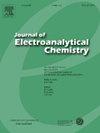高压石墨/钴酸锂成膜添加剂的筛选方法
IF 4.1
3区 化学
Q1 CHEMISTRY, ANALYTICAL
引用次数: 0
摘要
使用成膜添加剂是解决高活性电极与电解质不兼容问题的重要方法。然而,这些成膜添加剂的设计和筛选仍然依赖于试错法,效率低且成本高。在此,我们建立了一种以理论计算为基础、短期实验为补充的添加剂筛选方法。我们选择了四种含硫添加剂:1,3,2-二氧二噻烷 2-氧化物(PRS)、1,3-丙二醇环硫酸盐(PCS)、1,5,2,4-二氧二噻烷 2,2,4,4-四氧化物(MMDS)和砜烷(Sul)进行研究。理论计算结果表明,添加剂在阴极上的负吸附能大于溶剂,有利于阴极成膜。这一原理也可用于筛选阳极成膜添加剂。然而,计算结果只能说明添加剂参与成膜的能力,并不能揭示所形成的界面膜的稳定性或对电池电化学性能的改善。为了解决这一局限性,我们设计了三种高效的短期实验方法来表征界面薄膜的稳定性:电化学阻抗光谱法、高温(45 °C)储存法和时变测量法。所提出的方法结合了实验和理论计算,提高了筛选成膜添加剂的准确性。本文章由计算机程序翻译,如有差异,请以英文原文为准。
A screening method for film-forming additive in high-voltage graphite/LiCoO2
Using film-forming additive is an important approach to address the incompatibility between high-reactive electrodes and electrolytes. However, the design and screening of these film-forming additives still rely on a trial-and-error method, which is inefficient and costly. Herein, we established a method for screening additives based on theoretical calculations, and supplemented by short-term experiments. Four sulfur-containing additives, 1,3,2-dioxathiane 2-oxide (PRS), 1,3-propanediolcyclic sulfate (PCS), 1,5,2,4-dioxadithiane 2,2,4,4-tetraoxide (MMDS), sulfolane (Sul), were selected for investigation. The theoretical calculation results indicated that the additive with a greater negative adsorption energy on the cathode than the solvent facilitate film formation on the cathode. This principle can also be applied to screen the anode film-forming additive. However, the calculated results can only provide the insight into the additives’ capacity to participate in film formation, without revealing the stability of the resulting interfacial film or the improvement in the battery’s electrochemical performance. To address this limitation, three efficient short-term experimental methods were designed to characterize the stability of interfacial film: electrochemical impedance spectroscopy, high-temperature (45 °C) storage, and chronoamperometry. The proposed method, combing experiments and theoretical calculation, improves the accuracy for screening of film-forming additives.
求助全文
通过发布文献求助,成功后即可免费获取论文全文。
去求助
来源期刊
CiteScore
7.80
自引率
6.70%
发文量
912
审稿时长
2.4 months
期刊介绍:
The Journal of Electroanalytical Chemistry is the foremost international journal devoted to the interdisciplinary subject of electrochemistry in all its aspects, theoretical as well as applied.
Electrochemistry is a wide ranging area that is in a state of continuous evolution. Rather than compiling a long list of topics covered by the Journal, the editors would like to draw particular attention to the key issues of novelty, topicality and quality. Papers should present new and interesting electrochemical science in a way that is accessible to the reader. The presentation and discussion should be at a level that is consistent with the international status of the Journal. Reports describing the application of well-established techniques to problems that are essentially technical will not be accepted. Similarly, papers that report observations but fail to provide adequate interpretation will be rejected by the Editors. Papers dealing with technical electrochemistry should be submitted to other specialist journals unless the authors can show that their work provides substantially new insights into electrochemical processes.

 求助内容:
求助内容: 应助结果提醒方式:
应助结果提醒方式:


